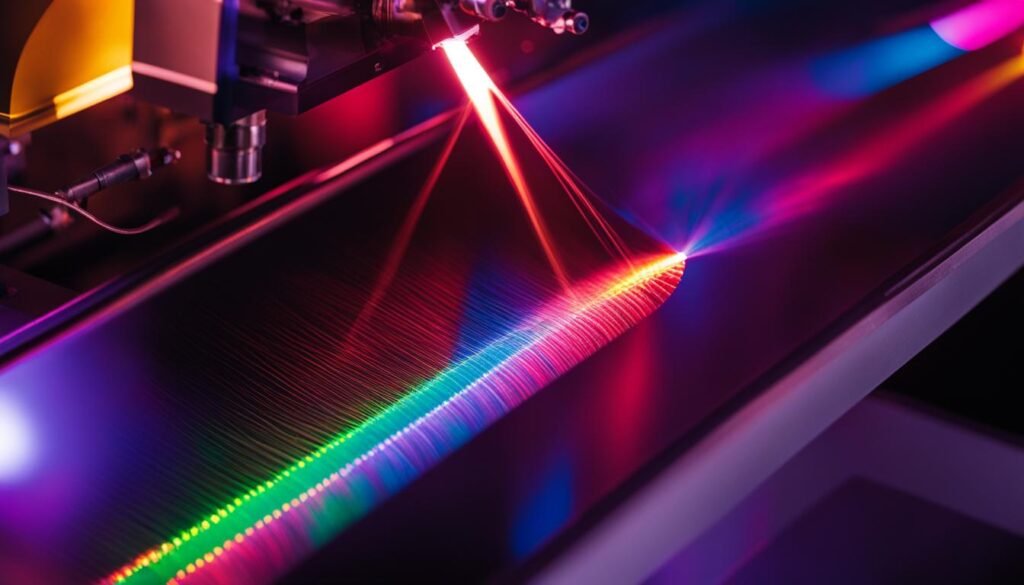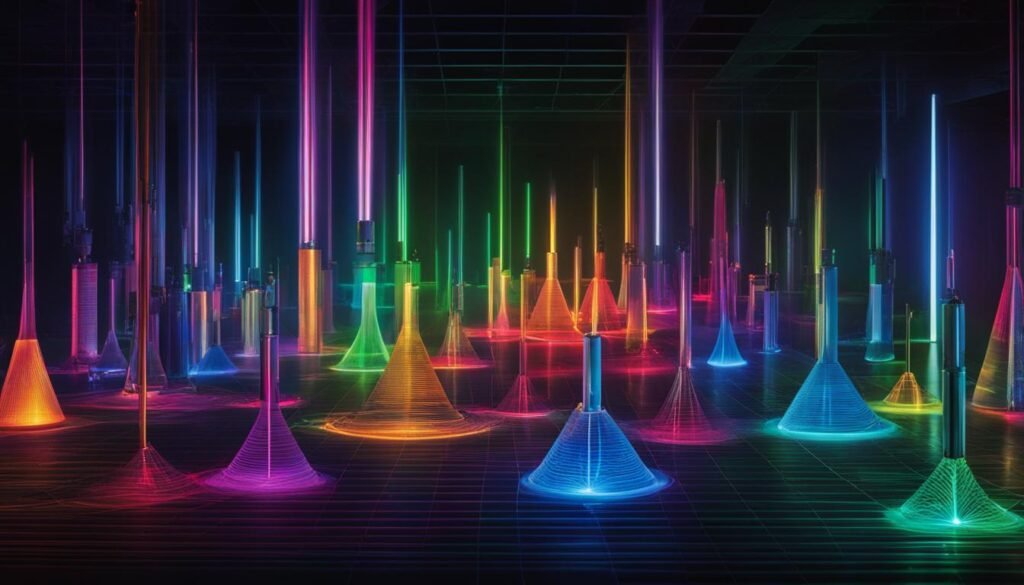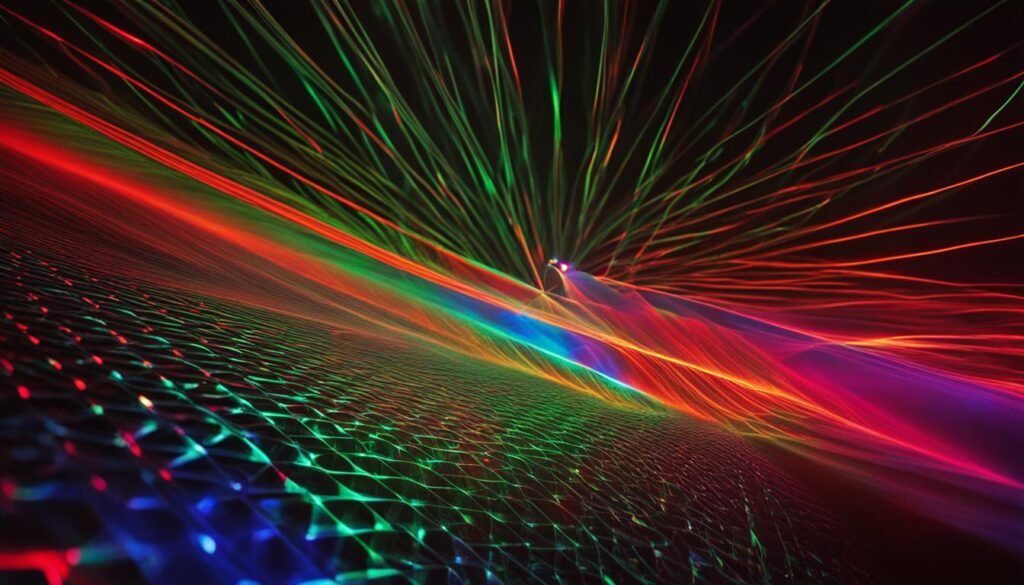Dye lasers are a fascinating field of laser technology that offers unparalleled versatility in various laser applications. These lasers utilize laser dye molecules as the gain medium, allowing for broad tunability from the near ultraviolet to the near infrared. With their unique properties, dye lasers have been instrumental in the development of many pioneering laser techniques and have found widespread use in fields such as spectroscopy, ultrashort pulse generation, laser amplification, and more.
Contents
Key Takeaways:
- Dye lasers are sources of tunable coherent radiation with broad tunability range.
- They can achieve high-pulse energies and high-average powers in the visible range.
- Dye lasers exhibit highly stabilized, single-longitudinal-mode operation.
- They have various applications, including laser spectroscopy, ultrafast studies, and medical diagnostics.
- Dye lasers can be pumped by different sources depending on the desired emission wavelength.
Mechanisms of Dye Lasers
Dye lasers operate based on the unique properties of laser dye molecules, which serve as the gain medium in these systems. Laser dye molecules are large molecules with atomic weights ranging from 175 to 1000 amu. They exhibit a wide absorption spectrum with strong absorption maxima corresponding to electronic transitions. The broadband gain and tunability features of dye molecules arise from the presence of closely lying vibrational levels within each electronic state.
The absorption and emission transitions of dye molecules are described by rate equations, which capture the excitation and deexcitation dynamics involved in the lasing process. This allows for precise control over the emission wavelength of dye lasers. Various pump sources can be used to excite the dye molecules, including frequency-doubled solid-state lasers, green lasers, ultraviolet light sources, flash lamps, and excimer lasers.
In dye lasers, the laser dye is typically dissolved in solvents such as ethanol, p-dioxane, or dimethylsulfoxide (DMSO) to form a dye solution. It is important to note that these dye solutions, as well as certain solvents used in dye lasers, can be toxic and hazardous if mishandled. Safety precautions must be taken when working with dye lasers to ensure the well-being of operators and to prevent any environmental hazards.
Applications of Dye Lasers

Dye lasers have found a wide range of applications in various fields due to their unique properties and capabilities. One of the key areas where dye lasers are commonly used is in laser spectroscopy. The broad tunability of dye lasers allows for precise control of the emission wavelength, making them ideal for studying the absorption and emission characteristics of different materials. Laser absorption spectroscopy, which involves probing and analyzing the absorption behavior of substances, benefits greatly from the tunability of dye lasers.
Another important application of dye lasers is in the generation of ultrashort pulses. Dye lasers can produce pulses with durations as short as femtoseconds, making them valuable tools for studying ultrafast phenomena in physics, chemistry, and biology. By harnessing the power of dye lasers, researchers can gain insights into the behavior of matter at incredibly short timescales, facilitating advancements in various scientific disciplines.
In addition to spectroscopy and ultrafast pulse generation, dye lasers are also widely used in laser amplifiers. They can boost the power of laser pulses, allowing for higher intensities and larger energy outputs. This is particularly useful in applications where high-energy laser beams are required, such as material processing and scientific research. The amplification capabilities of dye lasers make them versatile tools in these fields.
Furthermore, dye lasers have applications in medical diagnostics and treatments, environmental monitoring, and scientific research. Their tunability and versatility make them suitable for a wide range of experimental setups and requirements. Whether it’s analyzing biological samples, monitoring pollutants in the environment, or conducting cutting-edge research, dye lasers offer valuable solutions.
Dye Lasers in Laser Spectroscopy
Dye lasers are extensively used in laser spectroscopy due to their broad tunability and precise control of emission wavelengths. By selecting specific laser dyes and tuning their output, researchers can study various absorption and emission characteristics of materials. This allows for detailed analysis and understanding of the behavior of different substances, enabling advancements in fields such as chemistry, physics, and materials science.
Ultrafast Pulse Generation with Dye Lasers
Dye lasers are capable of generating ultrashort pulses with durations as short as femtoseconds. This ultrafast pulse generation is crucial for studying rapid processes that occur on extremely short timescales. By using dye lasers, researchers can capture and analyze these processes, leading to insights into fundamental phenomena and advancements in fields such as chemical dynamics, ultrafast spectroscopy, and biological imaging.
Dye Lasers in Laser Amplification
The amplification capabilities of dye lasers make them valuable tools in laser systems. Dye lasers can significantly increase the power of laser pulses, enabling higher intensities and larger energy outputs. This is important in applications that require high-energy laser beams, such as material processing, scientific research, and laser-induced plasma generation. Dye lasers provide the necessary amplification to meet the requirements of these demanding applications.
Pumping Options for Dye Lasers

Dye lasers utilize various pumping options to achieve their tunable coherent radiation. The choice of pump source depends on the specific dye and desired emission wavelength. Common pump sources include frequency-doubled solid-state lasers, green lasers, ultraviolet light sources, flash lamps, excimer lasers, and other lasers.
For example, rhodamine 6G lasers can be effectively pumped with a green laser, while dyes for shorter emission wavelengths may require ultraviolet light sources. The pump source provides the energy required to excite the dye molecules and initiate the lasing process.
In addition to the pump source, dye lasers can utilize different configurations for the laser gain medium. Two common options are dye jets and dye cuvettes. Dye jets involve exposing the dye molecules to the pump and laser beams for a short time, allowing for efficient energy transfer. On the other hand, dye cuvettes enclose the dye in a transparent material, providing easier flow control and longer interaction times between the dye and the pump and laser beams.
One challenge in dye lasers is the presence of triplet states, which occur when dye molecules become trapped and unable to participate in the lasing process. To mitigate this issue, triplet quenching agents can be added to the dye solution. These agents lower the concentration of triplet states, enabling more efficient lasing.
| Pumping Options | Pump Sources | Dye Configurations |
|---|---|---|
| Frequency-Doubled Solid-State Lasers | Green Lasers | Dye Jets |
| Ultraviolet Light Sources | Flash Lamps | Dye Cuvettes |
| Excimer Lasers |
In summary, dye lasers offer a range of pumping options to achieve their tunable coherent radiation. The appropriate pump source and dye configuration depend on the specific dye and desired emission wavelength. By carefully selecting the pumping options, researchers and professionals can optimize the performance of dye lasers in various applications.
Conclusion
In conclusion, dye lasers are highly versatile and flexible sources of tunable coherent radiation. With their broad tunability, high-pulse energies, and high-average powers, they find extensive applications in various fields. From laser spectroscopy to ultrashort pulse generation, dye lasers offer unique properties that make them indispensable in scientific research and other niche areas.
Although solid-state lasers have gained prominence in certain domains, dye lasers continue to play a crucial role where their distinct features are advantageous. Their ability to be pumped by a variety of sources adds to their versatility, allowing for tailored emission wavelengths based on specific dyes and applications.
As laser technology continues to advance, dye lasers remain a vital part of the laser landscape. Their contributions to frequency stabilization, pulse compression, and cavity and resonator innovations have paved the way for groundbreaking laser techniques. With ongoing developments in both dye molecules and pumping options, the future for dye lasers looks promising and holds countless possibilities for further innovation.
FAQ
What is a dye laser?
A dye laser is a unique source of tunable coherent radiation that offers unparalleled operational flexibility. It utilizes a gain medium composed of laser dye molecules to achieve tunability in a broad range of wavelengths.
How does a dye laser work?
Dye lasers work by pumping the laser dye molecules with an appropriate energy source, such as a frequency-doubled solid-state laser or an ultraviolet light source. The dye molecules absorb the energy and undergo electronic transitions, leading to the emission of coherent radiation in a tunable range of wavelengths.
What are the applications of dye lasers?
Dye lasers have a wide range of applications, including laser spectroscopy, laser absorption spectroscopy, ultrashort pulse generation, laser amplification, medical diagnostics and treatments, environmental monitoring, material processing, and scientific research.
What are the pumping options for dye lasers?
Dye lasers can be pumped by a variety of sources, such as frequency-doubled solid-state lasers, green lasers, ultraviolet light sources, flash lamps, and excimer lasers. The choice of pump source depends on the specific dye and desired emission wavelength.
Are dye solutions and solvents used in dye lasers hazardous?
Yes, dye solutions and some solvents used in dye lasers can be toxic and hazardous if mishandled. It is important to take proper precautions and handle them with care.



